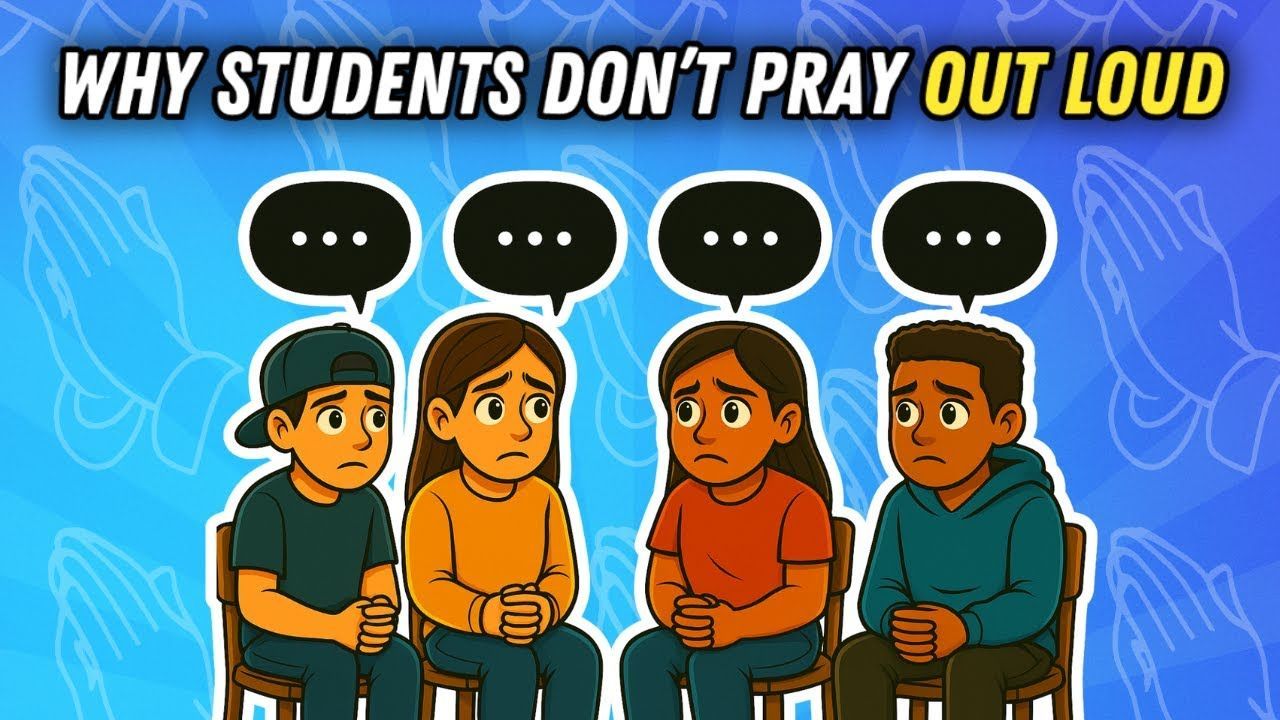Apathy Vs. Urgency: Why Teens Aren’t Sharing Their Faith and How to Change That | BTYR • Ep 56
Apathy Vs. Urgency: Why Teens Aren’t Sharing Their Faith and How to Change That | BTYR • Ep 56
Want to watch the podcast? Don't miss it! Click here for the video.
If you’re a youth leader,
you’ve likely seen the challenge of getting teenagers excited about evangelism. In this episode of the Beyond the Youth Room podcast, we’re diving into this common issue by exploring apathy versus urgency, identifying why teens aren’t sharing their faith, and discussing how we can help shift this mindset.
Youth leaders, parents, and mentors alike feel the tension when students don’t see the urgency in sharing the gospel. When we understand the gospel’s impact on everyday struggles, it sparks an urgency to share the good news—because Jesus doesn’t just save from the hell that lies ahead, but also offers hope in the middle of today’s struggles.
1. Set the Right Environment for Growth
We can’t force our students to share their faith, but we can create an environment where they are encouraged to step up. As Ryne, our fellow youth pastor, reminds us, setting the “temperature” for gospel urgency will allow students to rise to it. Even if only 10% of a youth group reaches the level of “disciple-maker,” it can make a noticeable difference. Just as Jesus looked on the crowds with compassion, we want our students to develop this same heart for the lost.
2. Address the Roots of Apathy
Youth today face unique barriers to sharing their faith. Our teens are often distracted by social media and busy lives, which crowds out their spiritual priorities. They might not actively choose to be apathetic, but they have so much else vying for their attention. If we help them identify and push back against these distractions, they can begin to focus more on their faith.
Another issue is that our digital age has affected how young people connect with others. While they may have many online “friends,” loneliness is still on the rise. Without deep, in-person relationships, they may find it harder to see the needs of others, much less feel the compassion to help meet those needs. On top of this, fear of rejection often silences them—especially in a culture that cancels and criticizes those who speak out. This fear can paralyze even the most compassionate students.
3. Shift Perspective to Create Gospel Urgency
At the heart of the issue, teenagers need to understand the gospel for themselves. Ryne and his team offer student missionary training that tackles three main components for motivating students to share the gospel: urgency, fluency (how to share), and strategy (how to start a gospel movement). This program has already trained over 1,300 students this year and helps youth see why sharing the gospel matters now.
When teens understand that Jesus’ message isn’t just for life after death but also offers hope for today, it reframes their urgency to share it. If we can help our students realize that the gospel can make a difference in their friends’ lives right now, sharing becomes more pressing.
4. Manage Expectations and Celebrate Small Wins
It’s natural for youth leaders to want all their students to be passionate about evangelism, but let’s be realistic. Not every teen in your ministry will become an outspoken evangelist overnight. At Ryne’s church, around 58% of students have shared the gospel with a friend. Even if only 10–20% of your group is actively sharing, you’re making progress.
5. Focus on Compassion and Eternal Perspective
Teenagers are often focused on the present, so helping them develop an eternal perspective is key. Talk with them about the value of making decisions today that impact their future and eternity. Compassion for others also needs to be part of the conversation. When students learn to view their friends with Christ-like compassion, it opens the door to a deeper commitment to sharing the gospel.
If you want support in fostering gospel urgency, consider joining our Youth Ministry Mastermind. In this online community, youth leaders from across the world—including South Africa, the Philippines, Singapore, Nigeria, and the UK—share insights, ideas, and experiences to encourage one another in youth ministry.
5 Practical Ways to Inspire Gospel Urgency in Youth Ministry
In youth ministry, inspiring a true sense of gospel urgency can be challenging, yet incredibly rewarding. By modeling and encouraging a heart for evangelism, we can empower young people to share their faith boldly and compassionately. Here’s a look at five effective strategies for creating gospel urgency in students:
1. Model Gospel Urgency
The first step to creating gospel urgency in students is modeling it yourself. When you show that sharing the gospel is a priority in your own life, students see it as attainable and meaningful. Just as Jesus came to earth, embodying His message to us, we too should live out our faith in a way that others can witness and imitate. Share stories of your own experiences in evangelism—both successes and challenges—to demonstrate that this journey is real and sometimes messy, but always purposeful. Research shows that students who see an adult share their faith are much more likely to try it themselves.
2. Celebrate Evangelism Successes
“Celebrate what you want to replicate.” When we highlight real stories of students who have shared the gospel, it motivates others to do the same. Acknowledging both the positive and the challenging aspects of evangelism makes it relatable and achievable. By creating a culture that celebrates boldness and courage in sharing the gospel, we send the message that this is what we value as a group.
3. Make Evangelism Relatable
Evangelism doesn’t have to be intimidating. Teach students that sharing the gospel can start with simple, everyday gestures—sharing their faith story, inviting friends to youth group, or offering to pray for someone. These small acts of faithfulness are accessible ways to start gospel conversations, making students more comfortable and confident in sharing their beliefs in authentic, relational ways.
4. Create Accountability
Accountability helps students keep gospel urgency at the forefront. Begin each small group meeting with a simple question: “Did you share the gospel with anyone this week?” Initially, this might be met with hesitation, but over time, it can lead to dynamic sharing sessions where students encourage each other and celebrate each other’s efforts. Accountability creates an environment where evangelism isn’t just talked about but becomes a shared experience.
5. Equip Students with Evangelism Tools
Evangelism takes courage, but it also takes skill. Make time to equip students with practical tools to confidently share their faith. Role-playing activities, discussion guides, and exploring different worldviews are great ways to help them feel prepared. Consider hosting a “AAA Café” or other creative exercises where students can practice having faith conversations in a safe, supportive setting.
Ultimately, nurturing gospel urgency in students is about fostering a ministry culture that values boldness, compassion, and intentionality in sharing faith. By modeling, celebrating, simplifying, and equipping, we can inspire students to share the gospel with the urgency it deserves.
Equipping Youth for Gospel Outreach: Inspiring Urgency in Evangelism
When it comes to inspiring gospel urgency in students, sometimes it takes creating opportunities to step out in faith—moments that might be intimidating at first but become a chance for growth. We’ve all been there, asking two brave students to come up and share. Though it's nerve-wracking, some kids are bold and willing to share. This not only builds their confidence but also opens up authentic conversations about faith.
In these moments, we guide students through real-life evangelism. We’ll simulate a scenario where a believer and a non-believer talk, helping our students learn how to answer challenging questions. It’s not just about having the right responses but understanding how a friend who isn’t a believer might react. This exercise lets students think deeply about the people they know and how to respond with compassion and clarity.
Beyond these exercises, resources are crucial. Student missionary training programs like those from Dare to Share offer a great start. Their digital curriculum is free, and platforms like Cutting Edge’s Student Missionary Training can guide students through structured lessons on sharing the gospel. This resource teaches gospel urgency, fluency, and strategy, helping students develop a heart for outreach and the practical skills to back it up.
There are many methods to choose from, such as Life in 6 Words or the 4-Part Gospel. Whichever approach you choose, it’s essential to teach a clear, understandable method. The Romans Road, 4 Spiritual Laws, or the One-Verse Method can all serve well—but the key is to pick one, teach it, and let the students make it their own.
For youth leaders, it’s important to remember: if students in our programs aren’t equipped to share the gospel, that reflects back on us. Every student should have a clear understanding of the gospel and be able to articulate it in under two minutes. Whether or not they share it often is ultimately up to them, but equipping them to share is up to us.
Lastly, remember the power of stories of impact. Real-life stories, whether of personal faith or others’ journeys, are incredibly inspiring. This, combined with practical training, accountability, and encouragement, can create a community of students passionate about spreading the good news.
If you’d like to learn more or dive deeper, join our online community. It’s a space to share resources, ask questions, and exchange ideas for equipping students to live out gospel urgency. We’d love to have you join and be a part of this movement toward inspiring the next generation in evangelism!











